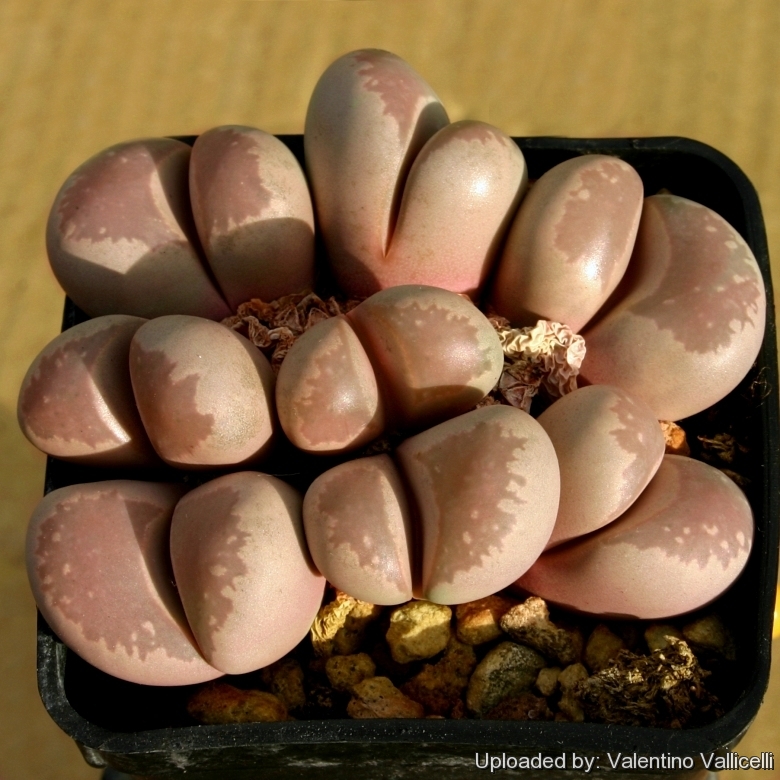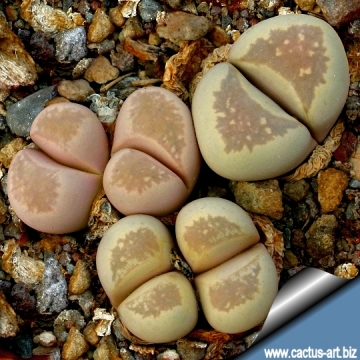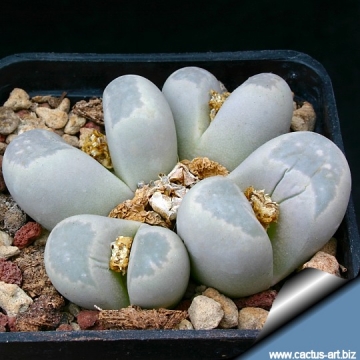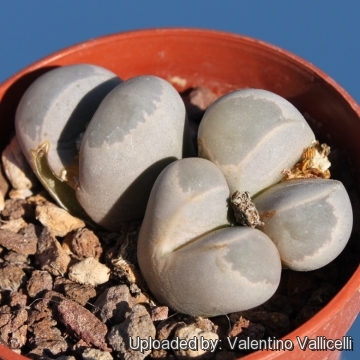Accepted Scientific Name: Lithops optica (Marloth) N.E.Br.
Gard. Chron. 1922, Ser. III. lxxi. 80. [18 Feb. 1922]

Mesembryanthemum marginatum (Lithops optica) Photo by: Valentino Vallicelli
(Locality: 10 km S Bakers Bay ) Many plants have pink hues.
Origin and Habitat: It is endemic to the Lüderitz district of the southern Namib Desert.
Habitat and ecology: It grows scattered in small colonies on desolate coastal plains and low hills. Its habitat is very sandy and it is often found growing among rocks and gravel where it is very difficult to spot. Its climate is cool due to the cold Atlantic Ocean and frequent fog, and rainfall is mainly during the winter, ranging between 20-50 mm per annum. They closely resemble the surrounding pebbles of their natural habitat, either in coloration and shape, this camouflage allows them to escape detection and is a very effective strategy for escaping predation. They are pollinated by bees, flies, wasps, gnats, bugs and other insects that are common in the area.
Synonyms:
See all synonyms of Lithops optica
back
Accepted name in llifle Database:Lithops optica (Marloth) N.E.Br.Gard. Chron. 1922, Ser. III. lxxi. 80. [18 Feb. 1922]Synonymy: 23
- Lithops optica (Marloth) N.E.Br.
- Lithops elevata L. Bolus
- Lithops optica C081 10 km W of Lüderitz, Namibia
- Lithops optica C275 10 km N of Lüderitz, Namibia
- Lithops optica C276 10 km S of Lüderitz, Namibia
- Lithops optica C277 10 km SW of Lüderitz, Namibia
- Lithops optica C286 10 km SW of Lüderitz, Namibia
- Lithops optica C288 40 km SSE of Lüderitz, Namibia
- Lithops optica C289 TL: 50 km S of Lüderitz, Namibia
- Lithops optica C290 65 km S of Lüderitz, Namibia
- Lithops optica C291 (maculate Form) 100 km SSE of Lüderitz, Namibia
- Lithops optica C292 120 km SSE of Lüderitz, Namibia
- Lithops optica C293 (maculate Form) 95 km SSE of Lüderitz, Namibia
- Lithops optica C294 140 km SSE of Lüderitz, Namibia
- Lithops optica C307 170 km SSE of Lüderitz, Namibia
- Lithops optica C310 160 km SSE of Lüderitz, Namibia
- Lithops optica C311 (maculate Form) 45 km SE of Lüderitz, Namibia
- Lithops optica C404 15 km N of Bogenfels, Namibia
- Lithops optica C414 Around Lüderitz Bay, Namibia
- Lithops optica var. minor H.Jacobsen
- Lithops optica var. nova W.Triebner in H.Jacobsen
Cultivars
(5):
back
Description: Lithops opticaSN|13175]]SN|13175]] is a tiny caespitose succulent forming with age small clusters of up to 20 bodies. It is possible to estimate the age of a Lithops opticaSN|13175]]SN|13175]] colony by counting the dried-up shells of old bodies, and specimens have been found with ages estimated at 50 to 95 years or more.
Stem: Very reduced and not visible.
Bodies (Paired leaves pairs): Up to 15 x 12 mm and up to 20 mm long in diameter. The leaf pairs are often unequal, oblong obconical (upside down cone-shaped) almost club-shaped, leaf tips convex with pronounced fissure making cleft, and windowed at their tops and with a smooth texture, whitish grey to grey green in colour with whitish transparent windows. Margins usually regular. The bodies become wrinkled during the dry summers. There is a reddish colour form, Lithops opticaSN|13175]]SN|13175]] cv. Rubra, with ruby milky pink sides and light to dark ruby-red windows.
Flowers: Daisy-like white, sometimes with pink tips, 12-25 mm in diameter and self-sterile
Blooming season: Flowers are diurnal and appear during autumn. They open late in the day and close up again at dusk.
Fruit: Capsule mostly 5-chambered. This capsule only opens when moistened, exposing the tiny seeds. In nature, falling rain drops splash out the seeds to a distance of a few centimetres to up to a metre or more from the parent plant. After the capsule dries up it closes again, protecting any seeds left behind.
Subspecies, varieties, forms and cultivars of plants belonging to the Lithops optica group
 Lithops optica (Marloth) N.E.Br.: form clusters of up to 20 bodies. The leaf pairs unequal, almost club-shaped, leaf tips convex with pronounced fissure making cleft, whitish grey to grey green with whitish transparent windows. Distribution: Lüderitz district of the southern Namib Desert.
Lithops optica (Marloth) N.E.Br.: form clusters of up to 20 bodies. The leaf pairs unequal, almost club-shaped, leaf tips convex with pronounced fissure making cleft, whitish grey to grey green with whitish transparent windows. Distribution: Lüderitz district of the southern Namib Desert.- Lithops optica C081 10 km W of Lüderitz, Namibia: grey green, clusters.
 Lithops optica C081A 10 km W of Lüderitz, Namibia cv. rubra: reddish purple bodies.
Lithops optica C081A 10 km W of Lüderitz, Namibia cv. rubra: reddish purple bodies. Lithops optica C275 10 km N of Lüderitz, Namibia: shiny green window, variable pattern.
Lithops optica C275 10 km N of Lüderitz, Namibia: shiny green window, variable pattern. Lithops optica C276 10 km S of Lüderitz, Namibia: often clumps from a very young age.
Lithops optica C276 10 km S of Lüderitz, Namibia: often clumps from a very young age.- Lithops optica C277 10 km SW of Lüderitz, Namibia: globose light green body.
 Lithops optica C286 10 km SW of Lüderitz, Namibia: many tinged pink.
Lithops optica C286 10 km SW of Lüderitz, Namibia: many tinged pink. Lithops optica C287 10 km SW of Lüderitz, Namibia cv. rubra: red lobed gems, pink tipped petals.
Lithops optica C287 10 km SW of Lüderitz, Namibia cv. rubra: red lobed gems, pink tipped petals.- Lithops optica C288 40 km SSE of Lüderitz, Namibia: quickly makes huge clusters.
- Lithops optica C289 TL: 50 km S of Lüderitz, Namibia: clustering with grey green bodies.
 Lithops optica C290 65 km S of Lüderitz, Namibia: translucent pale green bodies.
Lithops optica C290 65 km S of Lüderitz, Namibia: translucent pale green bodies.- Lithops optica C291 (maculate Form) 100 km SSE of Lüderitz, Namibia: mottled light grey pattern.
- Lithops optica C292 120 km SSE of Lüderitz, Namibia: pale white form, mottled lines.
- Lithops optica C293 (maculate Form) 95 km SSE of Lüderitz, Namibia: grey tinged pink.
- Lithops optica C294 140 km SSE of Lüderitz, Namibia: miniature grey opaque heads.
- Lithops optica C307 170 km SSE of Lüderitz, Namibia: open translucent lobes.
- Lithops optica C310 160 km SSE of Lüderitz, Namibia: flowers early.
 Lithops optica C311 (maculate Form) 45 km SE of Lüderitz, Namibia: vigorous, pale grey lobes.
Lithops optica C311 (maculate Form) 45 km SE of Lüderitz, Namibia: vigorous, pale grey lobes.- Lithops optica C404 15 km N of Bogenfels, Namibia
- Lithops optica C414 Around Lüderitz Bay, Namibia
- Lithops optica var. minor H.Jacobsen
 Lithops optica cv. rubra (Marloth) N.E.Br.: has ruby milky pink sides and light to dark ruby-red windows.
Lithops optica cv. rubra (Marloth) N.E.Br.: has ruby milky pink sides and light to dark ruby-red windows.- Lithops optica cv. rubra variegata: identical in shape to the standard species but have leaves variably striped with bright and dark purple-pink.
- Lithops optica cv. Rubragold (Marloth) N.E.Br.
Notes: The Lithops tipically grow sunken in the soil with only the upper truncated portion of leaves visible. This part is called the window, and it allows light into the inner portion of the leaf where it is diffused before reaching the green chlorophyll, which is scattered along the inner leaf margins, where the process of photosynthesis is carried out. The leaf pair is replaced by a new one every year and the leaf sap is recycled from the older to the younger leaf pair, thus maximising on moisture and nutrient conservation. Lithops plants will produce more than one leaf pair so that a single body gradually becomes a smallish cluster.
Bibliography: Major refences and further lectures
1) H. E. K. Hartmann “Illustrated Handbook of Succulent Plants: Aizoaceae F-Z” Springer, 2002
2) S. M Walters “The European Garden Flora Flowering Plants: Casuarinaceae to Aristolochiaceae” Cambridge University Press, 1989
3) Gardeners Chronicle Purnell and Sons 164: 14 (1968)
4) Clive Innes “Complete Handbook of Cacti and Succulents” Van Nostrand Reinhold Company, 01/Dec/1981
5) Cole, D. T. 1988. “Flowering stones” Acorn Books, Randburg. 1988
6) Smith et al. “Mesembs of the World.” Briza.Pretoria 1998
7) Leistner, O.A. (ed.), “Seed plants of southern Africa: families and genera” Strelitzia 10., National Botanical Institute, Pretoria 2000
8) Achim Hecktheuer “Mesembs, mehr als nur Lithops” Books on Demand GmbH Norderstedt. 2008
9) Desmond T. Cole & Naureen A. Cole, Uwe Beyer, Yves Delange “Les Lithops” SUCCULENTES Spécial 2008 AIAPS (now Terra seca). 2008
10) Desmond T. Cole & Naureen A. Cole “LITHOPS Flowering Stones” Cactus & Co. Libri. 2005
11) Yasuhiko Shimada “The Genus Lithops” Dobun Shoin. 2001
12) Rudolf Heine “Lithops - Lebende Steine” Neumann Verlag. 1986
13) Bernd Schlösser “Lithops – Lebende Steine” Praktische Anleitung für die Zimmerkultur. BussinessPoint MEDIA. 2000
14) Steven A. Hammer “Lithops – Treasures of the veld” British Cactus and Succulent Society. 1999
15) Desmond T. Cole “Lithops – Flowering Stones” Acorn Books CC. 1988
16) Gert Cornelius Nel “Lithops” Hortors Limited, South Africa 1946
17) David L. Sprechman “Lithops” Associated University Presses, Inc. 1970
 Mesembryanthemum marginatum (Lithops optica) Photo by: Cactus Art
Mesembryanthemum marginatum (Lithops optica) Photo by: Cactus Art Mesembryanthemum marginatum (Lithops optica) Photo by: Cactus Art
Mesembryanthemum marginatum (Lithops optica) Photo by: Cactus Art H4707 clear umblemished top, clustering (MG 1683.3) (Lithops optica) Photo by: Valentino Vallicelli
H4707 clear umblemished top, clustering (MG 1683.3) (Lithops optica) Photo by: Valentino VallicelliSend a photo of this plant.The gallery now contains thousands of pictures, however it is possible to do even more. We are, of course, seeking photos of species not yet shown in the gallery but not only that, we are also looking for better pictures than those already present.
Read More... Cultivation and Propagation: Lithops optica is relatively easy to grow but great care needs to be taken with soil, temperature, time and amount of watering. It is a winter growing species and heads for dormancy in summer.
Growth rate: It is slow growing but clustering in cultivation, if grown correctly, it will reward the grower with generous displays of flowers.
Soil: Since roots are quite shallow, use a sandy gravel mixture (e.g. 2 parts sand : 1 part clay loam : 1 part gravel) or a cactus mix with extra perlite or pumice. For best results, use a shallow pot, and only use the smallest diameter pot that will accommodate the plant. Clay pots help the plants to dry out between watering.
Waterings: Requires little water, otherwise its epidermis breaks (resulting in unsightly scars). Watering should be very sparing and regular only during the late autumn and early winter months, e.g. no more frequently than once in two weeks, but when watered, they should be drenched so that the water reaches the bottom of the container. Water minimally in summer, only when the plant starts shrivelling. It is also best to water in the mornings so that the excess water evaporates and the upper layers of soil dry out fairly quickly. No water should ever be allowed to stand around the roots.
Exposure: Keep cool and shaded in summer, needs full sun or light shade in the other seasons. High levels of light are needed in autumn to flower and for good plant development. The low intensity of sun light during the growing season of this species generally prevents the white flower flowers from opening.
Special Advice: Lithops are best planted in a sunny and airy part of the greenhouse, and not too close to the glass roof or sides of the house as the plants can overheat during hot spells.
Fertilization: Need a perfect fertilizer diet during the growing season. Feed them once during the growing season with a fertilizer specifically formulated for cactus and succulents (high potash fertilizer with a dilute low nitrogen), including all micro nutrients and trace elements diluted to ½ the strength recommended on the label. They thrive in poor soils and need a limited supplies of fertilizer to avoid the plants developing excess vegetation, which is easily attacked by fungal diseases. Some growers fertilize frequently, some hardly ever. However, for the highly succulent mesembs, fertilization is not really necessary.
Hardiness: Although the plant will survive mild frost if kept dry (hardy as low as -5° C) it should be protected from severe cold and prolonged frost conditions.
Rot: Rot is only a minor problem with mesembs if the plants are watered and “aired” correctly. If they are not, fungicides won't help all that much. The plant turns immediately to mush when over watered, or watered out of season. Care must be given in watering, keeping them warm and wet while growing, and cooler and dry when dormant.
Reproduction: Seeds, cuttings or division. Sow them in spring or autumn. Germination usually occurs within about a week or two. Seed germinate at 15-21 °C. Cover the seeds with a very fine layer of grit and water from below with a fungicide to prevent damping off. For the first 3-4 days cover the pots with a sheet of glass/clear perspex to keep the humidity levels high. Remove the glass and replace it with light shadecloth and mist once or twice a day for the next two weeks after which most seeds should have germinated. From then on mistings can be reduced to every second and then every third day as the little plants grow. The young plants can be transplanted after a year, and flowering can be achieved within 3-4 years. The seed will remain viable for many years provided it is stored in a cool dry place. It is also possible to divide a multiheaded plant, but lithops prefer to grow clustered together and many growers prefer to leave them undisturbed to see how large a cluster can get. To separate a cutting from a grown-up mother, lift the plant, carefully cut through the rootstock. Each cutting must contain one or more heads along with a fraction of root and permit them to dry out a couple of days, lay the cuttings on the soil and insert the stem end partially into the soil. Try to keep the cutting somewhat upright so that the roots are able to grow downward.













